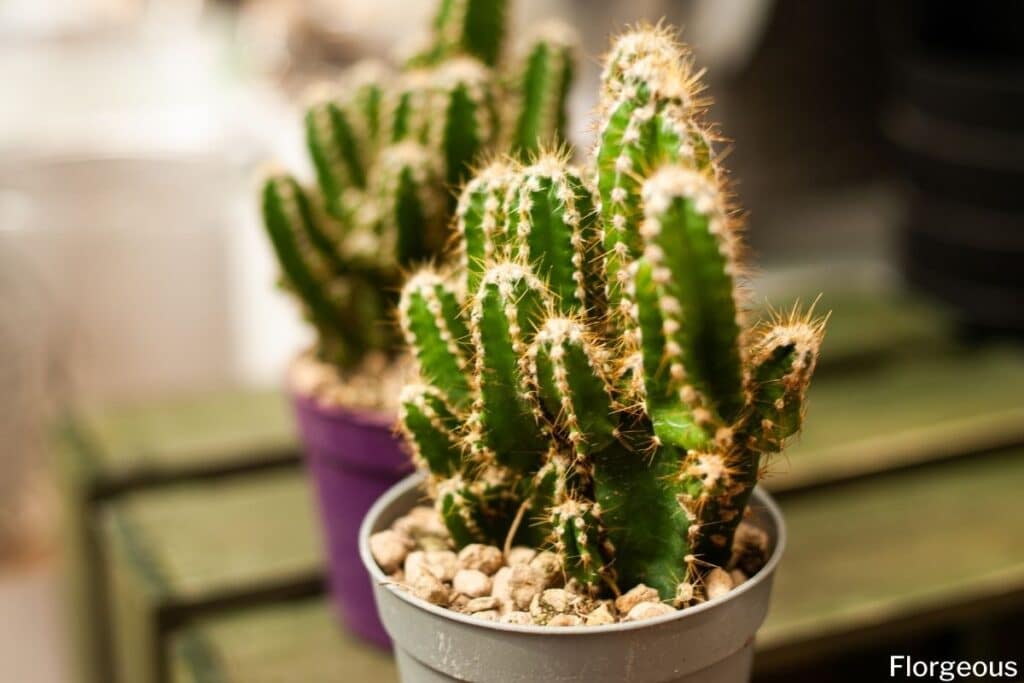The reason why cactuses make good house plants, aside from their undemanding nature, is their peculiar, often awe-inspiring visual impact. Their shapes and forms produce an ornamental quality as seen on the ‘Fairy Castles’ cactus.
Resembling a miniature cluster of towers on top of each other, one can almost expect fairies and tiny magical creatures to appear from this cactus.
If you’re looking to add more charming cactus types to your collection, here is a practical guide to grow and care for a Fairy Castle cactus.
What is Acanthocereus tetragonus?
Acanthocereus tetragonus ‘Fairy Castles’ (formerly Cereus tetragonus), commonly called Triangle cactus or Barbed-wire cactus, is a fleshy upright cactus that has a growth habit almost the same as that of the Dragon fruit plant.
The slender sharp-ribbed stems gathered near the base of the plant can grow as long as 7m, hence the clambering or arching appearance of mature plants in their native habitats in Central America and Northern South America.
This intimidating cactus has a cultivar that has become popular among indoor plant growers, A. tetragonus ‘Fairy Castles’. Unlike the species, this cultivated variety can only reach up to a height of 1 m (23 ft) and a spread of 30 cm (1 ft).
The bright green stems branch out from the base of the plant and on top of each other, creating a compact cluster of what looks like small turrets on a castle, hence the name. Along the stem ribs are small aeroles of yellowish bristles and spines.
Although rarely seen on plants grown indoors, triangle cactus produces white or yellow gerbera-like flowers that bloom in the night during mid-summer to fall.
Landscape and Horticultural Uses
A. tetragonus can form an impenetrable thicket so in areas where it is native, the plant is utilized as a bold, often protective, landscape barrier or fence. Cultivated varieties like ‘Fairy Castles’ are commonly grown in pots or containers and can also be used as a border or focal point in desert-themed gardens.
In many places where the Acanthocereus Tetragonus Fairy Castle is introduced like in some parts of Australia, this cactus is considered an invasive weed. It interferes with the growth of their native plants that’s why the use of Barbed-wire cactus as a landscape plant is limited.
Fairy Castle Cactus Care Guide
Growth Requirements
The triangle cactus needs bright full sun exposure to maintain its vibrant color. It will also grow best when the temperature is between 50-86 °F (10-30°C).
However, extreme heat and temperature in USDA Hardiness Zones 9-11 may cause stem burn and discoloration, so a bit of shade is necessary during summer. When placed indoors, the fairy castle cactus plant will benefit from periodic rotation to maintain its upright growth.
As a cactus, this cultivar can withstand long periods of drought so only water when the top 2 cm (3/4 in) of the soil is completely dry. Watering should be reduced as the cold months approach, and then keep the soil dry to prevent excess moisture during the winter.
In fact, during the colder months, you can water it in half the amount of water compared to the warmer seasons. This approach ensures that your cactus remains healthy and thrives throughout the year.
In the wild, fairy castle cactus thrives in sandy soils so when grown as a houseplant, it is important to mimic their natural habitat but at the same time, provide nutrients to maintain its lush appearance. The well draining soil is ideal to prevent wet soil, a soil mixture of 2/3 coarse materials like sand and perlite and 1/3 commercial cactus potting soil is recommended.
Propagation and Maintenance
The triangle cactus takes years to be mature enough to produce yellow flowers and since it is a cultivated variety, it is not likely to produce viable seeds that are true to type. Propagation is possible through stem fragments or cuttings.
Propagules can be collected by carefully slicing stems off the clustered plants. The wounds of the cuttings are allowed to heal and form calluses by placing them on a flat surface in a well-ventilated, partially shaded area.
It is important that the area is not drafty and wet as this may lead to rotting of the cuttings. Once healed, they are then planted on a well drained soil, callused end first, to allow root formation. They will take about a month to establish as new fairy cactus.
Some of Fairy Castles’ notable features are its bright green color and compact appearance. To maintain them in an indoor or garden setting, it is recommended to apply a low-nitrogen fertilizer reduced at half strength every 2 months, except during fall and winter.
This cactus is prone to rotting so make sure that the soil mixture is porous and the unglazed clay pot has proper drainage holes to prevent waterlogging. The full sun plant is also susceptible to mealybugs, scale insects and spider mites. Watch out for these pests and treat them promptly with a mild soap and water spray or by manually removing them.
FAQs
Is a Fairy Castle Cactus indoor or outdoor?
Fairy Castle Cactus is typically grown indoors but can also be placed outdoors in a bright sunny location with warm, dry climates.
How fast do Fairy Castle Cactus grow?
Fairy Castle Cactus is a very slow growing plant, adding about 1-2 inches in height per year under optimal conditions.
Why is my Fairy Castle Cactus turning brown?
Browning of a Fairy Castle Cactus could indicate overwatering, exposure to cold drafts, or fungal diseases. Ensure proper drainage and avoid watering excessively.
Do Fairy Castle Cactus need sun?
Yes, Fairy Castle Cactus requires plenty of sunlight to thrive, preferably direct light for several hours a day. Position it near a south-facing window for best results.
References
References
Global Invasive Species Database. Acanthocereus tetragonus. Invasive Species Specialist Group. 2008, http://issg.org/database/species/ecology.asp?si=1248&fr=1&sts=&lang=EN. Accessed 11 June 2021.
Staehling, A. Happy Houseplants. Chronicle Books. 2017. P. 96.
Atlas of Living Australia. Acanthocereus tetragonus. Department of Agriculture, Water and the Environment. 2020, https://profiles.ala.org.au/opus/weeds-australia/profile/Acanthocereus%20tetragonus. Accessed 10 June 2021.
Victorian Resources Online. Barbed-wire cactus (Acanthocereus tetragonus). Agriculture Victoria. 2021, http://vro.agriculture.vic.gov.au/dpi/vro/vrosite.nsf/pages/weeds_barbed-wire-cactus. Accessed 10 June 2021.
Allaway, Z. & Bailey, F. Practical Cactus and Succulent Book. Penguin. 2019. P. 224.
Close







